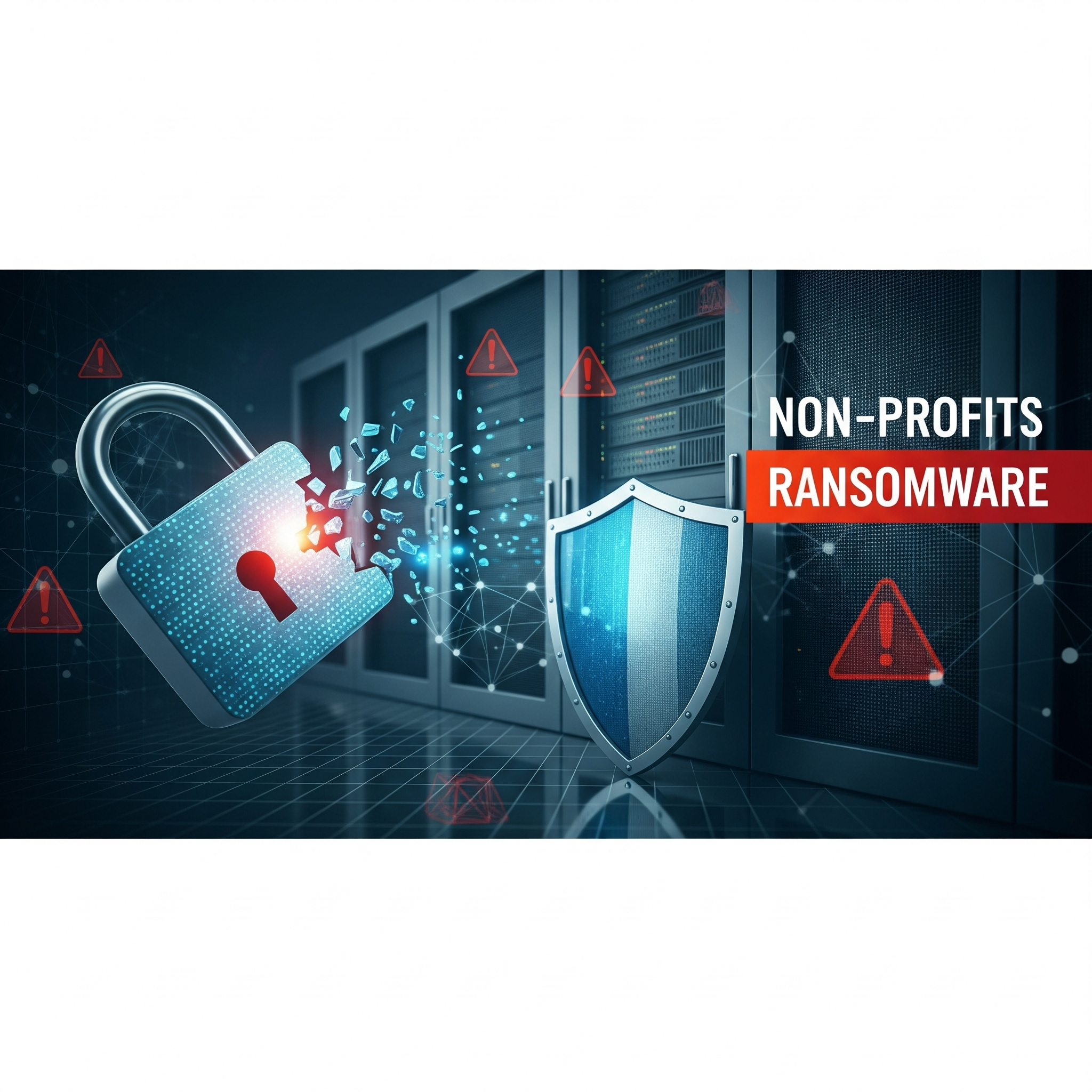You know what’s devastating? When the people trying to help the most vulnerable become victims themselves. That’s exactly what happened to dozens of charities across the globe this year.
Let me tell you about a charity that thought they were doing everything right. They had backup systems, multiple IT vendors, even some security measures in place. But when a single email hit their network on a Monday morning, everything changed.
The Day the Mission Stopped
The charity’s operations team arrived at work to find their computers locked with ransom messages. Every screen displayed the same ominous warning; their files encrypted, their data held hostage, and payment demanded in Bitcoin.
This wasn’t just an inconvenience. It was a complete operational shutdown that lasted weeks. HR couldn’t access employee records. Payroll systems were down for seven days, meaning staff, many living paycheck to paycheck, couldn’t get paid. A month later, remote employees still couldn’t access parts of the network they needed.
Here’s the scary part: this wasn’t some small operation. They had 50 servers, multiple IT vendors, and what they thought was adequate security. But when the attack hit, they discovered their backup systems only covered 23 of those 50 servers. The rest? Gone.
The Anatomy of a Targeted Ransomware Attack
So how did this happen? The attack started with something we see every day, a generic email with a PDF attachment. Nothing suspicious on the surface. But that PDF contained REvil ransomware, and once one employee opened it, the infection spread like wildfire.
The criminals knew exactly what they were doing. They targeted the charity during one of their busiest periods; processing donations, managing programs, coordinating volunteers. The timing wasn’t coincidental.
Nonprofits have become the second most targeted sector by cybercriminals, accounting for 31% of all nation-state attacks detected by Microsoft. And the numbers are getting worse. Email-based threats against nonprofits increased by 35.2% just last year.
The Human Cost of Digital Warfare
What makes this story particularly heartbreaking is the ripple effect. This charity serves as a central hub for marginalized communities, providing a safe space for people with nowhere else to turn. When their systems went down, it wasn’t just about lost data or delayed paychecks. It was about vulnerable people who couldn’t access the services they desperately needed.
The staff resorted to using a temporary Gmail account for communication. Imagine trying to coordinate critical social services through a basic email when your entire infrastructure is destroyed. The psychological toll on employees was immense; they felt like they were failing the very people they’d dedicated their lives to helping.
The Financial Reality of a Ransomware Attack
The charity chose not to pay the ransom, which was the right decision. But that choice came with its own costs. While their last backup was successful, it hadn’t been updated with the previous weeks’ worth of operational data. That means donation records, program information, and critical communications were simply gone.
The average cost for a nonprofit to recover from a ransomware attack is around $10,000, but that’s just the beginning. Recovery costs can reach $2.75 million when you factor in legal fees, IT recovery, potential fines, and increased insurance premiums. For organizations operating on shoestring budgets, these expenses can be organizational death sentences.
How to Protect Your Organization from a Ransomware Attack
Look, I’ve seen too many good organizations get hit by these attacks. But here’s what I’ve learned. The charities that survive aren’t the lucky ones, they’re the prepared ones. Let me share what actually works.
- Implement Email Security That Actually Works: Nearly 80% of charity cyber breaches come through phishing emails. You need AI powered email security that detects sophisticated phishing attempts before they reach your team. Generic filters aren’t enough when attackers are using AI to create convincing fake messages.
- Establish Proper Backup Procedures: This charity had backups, but they were incomplete and untested. Your backup strategy needs to include regular, encrypted backups stored offline or in segregated cloud environments. More importantly, you need to test your restoration procedures monthly. Having backups doesn’t matter if you can’t actually restore from them when disaster strikes.
- Training Your Team on Social Engineering: The attack started with one employee opening what appeared to be a legitimate PDF. Your team needs ongoing training on how to recognize sophisticated phishing attempts, particularly those from seemingly trusted sources. Make sure everyone has cybersecurity awareness training, and knows the procedures for verifying suspicious communications.
- Segment Your Network: This attack spread through the entire network because systems weren’t properly isolated. You need to divide your network into separate segments with different access controls. Even basic network separation can significantly limit attack spread and protect your most critical systems.
- Deploy Multi-Factor Authentication (MFA): Even if criminals compromise your passwords, MFA prevents unauthorized access by requiring a second verification method. This simple measure significantly reduces the risk of account takeovers from stolen credentials.
The Broader Threat to Nonprofits
Here’s something that should concern every nonprofit leader: 56% of NGOs (non government organization) don’t have a budget for cybersecurity, and 70% don’t believe they have the knowledge or skills to respond to a cyberattack. This creates a perfect storm for criminals who specifically target vulnerable organizations.
The attacks aren’t random. Cybercriminals target nonprofits because they hold valuable data, operate on limited budgets, and often rely on volunteers who may not have formal cybersecurity training. Your donor information, beneficiary records, and financial details are incredibly valuable on the black market.
The Competitive Reality
Here’s something most nonprofit leaders don’t realize. Strong cybersecurity is becoming a competitive differentiator. Donors are increasingly choosing organizations based on their security posture. When potential supporters see that you’ve invested in protecting their information, it builds trust and credibility.
On the flip side, a data breach can permanently damage your reputation. According to research, 36% of nonprofit leaders consider reputational risk the biggest concern related to cybersecurity breaches. Once trust is broken, it’s incredibly difficult to rebuild.
Your Action Plan
Don’t wait until you’re the next victim. Start with these immediate steps:
- Evaluate your current backup systems – Are they comprehensive? Are they tested monthly?
- Implement advanced email security – Generic filters aren’t enough in 2025.
- Establish network segmentation – Isolate critical systems from general access.
Remember, this charity had multiple IT vendors and thought they were protected. The difference between surviving and becoming a cautionary tale isn’t about having security measures, it’s about having the right security measures implemented correctly.
Book a 15-minute Cybersecurity Strategy Call to discuss which security measures would have the biggest impact on your specific organization and how to implement them without breaking your budget.
FAQ
Q: How can small nonprofits afford comprehensive cybersecurity? Focus on the fundamentals first. MFA, proper backups, and email security. These provide significant protection at relatively low cost. Many cybersecurity providers offer nonprofit discounts.
Q: What should we do if we’re hit by a ransomware attack? Don’t pay the ransom. Contact law enforcement immediately, isolate affected systems, and work with cybersecurity professionals to assess the damage and begin recovery.
Q: How can we tell if our current security is adequate? If you haven’t had a professional cybersecurity assessment in the last 12 months, your security posture is likely inadequate for today’s threat landscape.
Q: Are cloud services safer than on-premise systems? Cloud services often provide better security for nonprofits because they have dedicated security teams and resources. However, you still need proper access controls and backup procedures.
Q: How often should we update our security measures? Cybersecurity isn’t a one time investment. Threat landscapes evolve constantly, so your security measures should be reviewed and updated quarterly at minimum.
This article is the second in a series examining real cybersecurity incidents and how to prevent them. Each story is based on documented cases and current security research.



